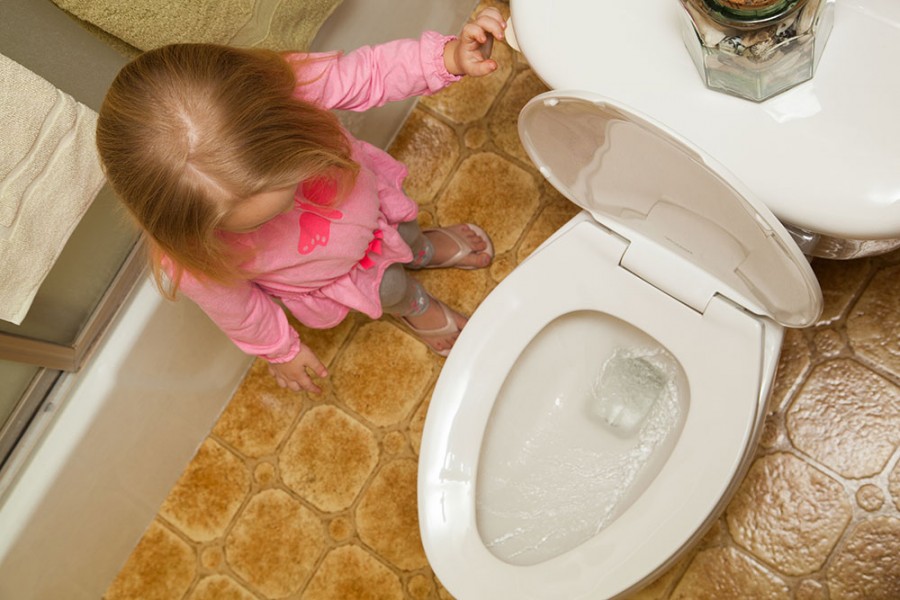Most people only think about toilets on an as-needed basis, or on those unfortunate and annoying occasions when the toilet stops working. But did you know that flushing toilets is the largest indoor use of water in California? Statewide, there are 30 million toilets and 1 million urinals. California consumes about 443 billion gallons of water a year for flushing toilets and urinals and running faucets in domestic kitchens, bathrooms and public restrooms.
Although the rain and snow has returned with this year’s El Nino, California is still in a drought and the state government continues to mandate conservation, including new toilet efficiency standards. All new toilets sold in California must now use 1.28 gallons or less per flush. In comparison, many of the older toilets still in many people’s houses use 3.5 gallons per flush or even more.
Coupled with regular attention to leaks, replacing high-flow toilets can cut per-person water use by 35 percent, estimates show. To encourage people to replace their old, water-hogging toilets, California’ Save Our Water initiative includes a High Efficiency Toilet Rebate Program that provides up to $100 towards a new high-efficiency toilet. Rebates are available to all California residents who pay a water bill and are replacing a toilet that uses more than 1.6 gallons (6 liters) of water per flush.
Robyn DiFalco, executive director of the Butte Environmental Council in Chico, has first-hand experience of upgrading to water saving toilets:
“I replaced the toilets in my house with low flow toilets a few years ago. Unfortunately, both times that we replaced them, the rebates had run out, but it was still a worthwhile change to make – the new toilets work great and make it easy to save lots of water.”
She also has some suggestions for those who can’t afford to replace their toilets or aren’t eligible for the rebate: “As an alternative, you can put a brick or a full water bottle in the toilet tank, which will displace some of the water in the tank so that less is used with each flush. Most toilets are capable of flushing with less water.”
There’s also always the time-tested drought water-saving strategy of “If it’s yellow, leave it mellow, if it’s brown, flush it down . . .”
High-efficiency toilets help cities save water and comply with water conservation mandates, but they can complicate things a bit for municipal sewage systems, as Tracy Wyhlidko, industrial waste supervisor at the City of Redding, explains: “The slope of sewer pipes is built to standards based on flow calculations for old-style toilets. In newer subdivisions where all the toilets are low-flow, there isn’t always enough water coming through the sewer pipes to keep things flowing through. To avoid blockages or backups, city workers actually have to flush out these sewer pipes more often, using city water supplies.” Despite this issue, Wyhlidko agrees that water saving toilets are a great innovation for saving water and perform just as well or better than those that use more water.
It’s important to remember (especially for people who have a domestic well at home) that every gallon of water used requires energy to pump it to where we are using it, so saving water also saves energy.
For more information on the California toilet replacement rebate program, see the Save Our Water website at: http://www.saveourwaterrebates.com/toilet-rebates.html.
Posted in: Community
Comment Policy: All viewpoints are welcome, but comments should remain relevant. Personal attacks, profanity, and aggressive behavior are not allowed. No spam, advertising, or promoting of products/services. Please, only use your real name and limit the amount of links submitted in your comment.
You Might Also Like...

Mamapreneurs 2021
Each year, North State Parent celebrates entrepreneurial women of the North State who have integrated their own business or side hustle into the challenging and rewarding job of motherhood. These […]
Bridging The Gap: Providing Clean Water for Millions
Humanitarian projects often sprout from a moment of inspiration then grow with commitment and lots of hard work. Bridging the Gap, founded by Shirley Adams of Chico, followed this pattern. […]

Foster Care and Adoption – A Family in the Making
With over 400,000 American children in foster care, and nearly 120,000 waiting for adoption, it is clear that families are waiting to be made. November is National Adoption Awareness Month, […]

Movement Jumpstarts the Brain – Flipping the Learning Switch at Blue Oak School with S’cool Moves
“Our highest endeavor must be to develop free human beings who are able, of themselves, to impart purpose and direction to their lives.” Rudolf Steiner (1861-1925) Today, parents have choices […]

The Importance of the Arts: Experts Share their Perspectives
Children are born artists. Even young children know how to create – thrilled by the magical sound made by tapping on piano keys, by the texture of fingerpaints, by the […]

Art! It’s Fun & Fundamental – Three North State Studios Offer Arts Classes for Healthier, Happier People.
Many people appreciate the enjoyment received from creating art, but probably few understand its benefits to health and happiness. Making art teaches appropriate ways to problem solve and deal with […]


